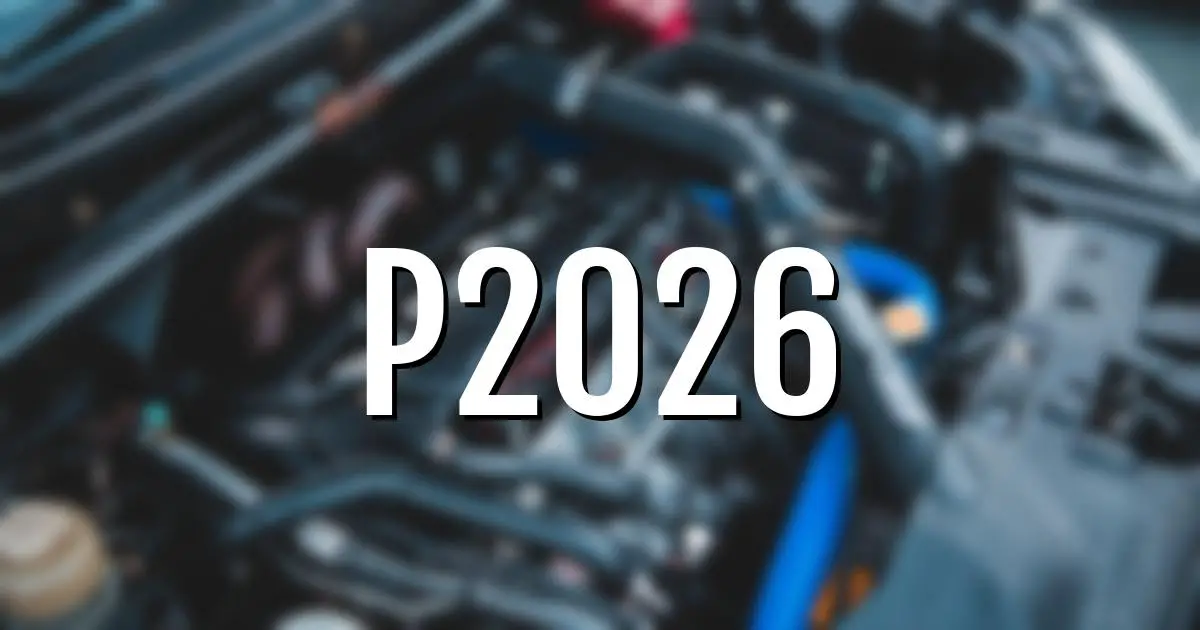If you see the Engine Light ON or Service Engine Soon Warning Light, it could be due to the P2026 fault code.
This code indicates a problem with the Natural Vacuum Leak Detection (NVLD) module, which could be faulty or have a poor electrical connection. It could also be due to an open or shorted NVLD module harness or a faulty Powertrain Control Module (PCM). The importance of fixing this issue lies in the fact that it could lead to decreased fuel efficiency and increased emissions.
The repair difficulty is moderate, with a repair time of 1.0. To fix the issue, you should visually inspect the related wiring harness and connectors, check for damaged components, and look for broken, bent, pushed out, or corroded connector’s pins.
| Repair Importance Level | 10.0 (Out of 10) |
| Estimated Repair Time | Approximately 1.0 hour |
| Repair Difficulty Level | 10.0 (Out of 10) |
P2026: Uncovering The Telltale Signs Of A Faulty Fuel Cap
If you notice the Engine Light ON or Service Engine Soon Warning Light, it could be a sign of p2026 fault code.
Here are the symptoms to look out for:
- The P2026 fault code in an automobile can cause several symptoms.
- The most common symptom is the illumination of the engine light or service engine soon warning light.
- Other symptoms include a decrease in engine power, rough idling, stalling, and difficulty starting the engine.
- Additionally, the vehicle may experience poor fuel economy, reduced acceleration, and increased emissions.
- It is important to address these symptoms promptly to prevent further damage to the vehicle and ensure safe driving conditions.
P2026: Fuel Rail Pressure Low – Common Causes
P2026 fault code can be caused by a faulty NVLD module, open harness, poor electrical connection, or a faulty PCM.
- The automobile fault code P2026 can be caused by a faulty Natural Vacuum Leak Detection (NVLD) module.
- It can also be caused by an open or shorted NVLD module harness.
- Another cause can be a poor electrical connection in the NVLD module circuit.
- Lastly, a faulty Powertrain Control Module (PCM) can also trigger this fault code.
Fix P2026: Simple Steps To Solve The Issue
To fix the p2026 automobile fault code, check the possible causes and inspect related wiring harness and connectors for damage.
- To fix the automobile fault code P2026, you need to check the possible causes listed above.
- Visually inspect the related wiring harness and connectors for any damage.
- Look for broken, bent, pushed out, or corroded connector’s pins.
- This fix will take an estimated repair time of 1.0 hour.
P2026: Affordable Fix For Complex Automobiles
The fault code P2026 indicates an issue with the fuel rail pressure sensor circuit. The estimated repair time for this fault code is 1.0 hour. The cost of fixing this issue can vary depending on the auto repair shop, but it is common for most shops to charge between $75 and $150 per hour.
Other factors that may influence the cost include the severity of the issue, the type of vehicle, and the location of the repair shop.
P2026: Fuel Level Sensor B Circuit Range/Performance
The P2026 code is related to the Evaporative Emissions Fuel Vapor Temperature Sensor Circuit.
The Powertrain Control Module (PCM) monitors the Natural Vacuum Leak Detection (NVLD) module input for expected NVLD ambient temperature sensor values.
If the input is outside a calibrated set of limits, the P2026 code sets.
This code indicates that the fuel vapor temperature sensor circuit is experiencing low voltage.
FAQ
If the Natural Vacuum Leak Detection (NVLD) module is not faulty, the P2026 fault code could be caused by a faulty Powertrain Control Module (PCM), an open or shorted NVLD module harness, or a poor electrical connection in the NVLD module circuit. To fix the issue, it is recommended to visually inspect the related wiring harness and connectors, check for damaged components, and look for broken, bent, pushed out, or corroded connector’s pins.
If you’re experiencing an Engine Light ON or Service Engine Soon Warning Light due to a P2026 fault code, it could be caused by a faulty Natural Vacuum Leak Detection (NVLD) module, an open or shorted NVLD module harness, a poor electrical connection in the NVLD module circuit, or a faulty Powertrain Control Module (PCM). To fix this issue, visually inspect the related wiring harness and connectors for any damaged components, broken, bent, pushed out, or corroded connector’s pins. Check the “Possible Causes” listed above for further guidance.
Replacing the Powertrain Control Module (PCM) may not be necessary to fix the P2026 fault code. The engine light may be on due to a faulty Natural Vacuum Leak Detection (NVLD) module, an open or shorted NVLD module harness, or poor electrical connection in the NVLD module circuit. To fix the issue, inspect the related wiring harness and connectors for any damage or corrosion and check for broken or bent pins.

Wrap Up
If your engine light is on, it could be due to a faulty Natural Vacuum Leak Detection (NVLD) module or a poor electrical connection. To fix it, visually inspect the wiring harness and connectors for damage or corrosion. Check for broken or bent pins.
Also, check the Powertrain Control Module (PCM).
